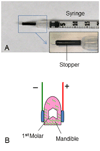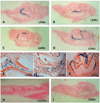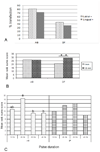Electroporation to deliver plasmid DNA into rat dental tissues
- PMID: 21157822
- PMCID: PMC3071707
- DOI: 10.1002/jgm.1521
Electroporation to deliver plasmid DNA into rat dental tissues
Abstract
Background: Delivery of DNA into the target tissues is an important technique in gene function studies and gene therapy. Surgical treatment of tooth eruption disorders, such as impacted third molars, is a major healthcare cost. Because the dental follicle (DF) is essential for regulating tooth eruption, establishment of local gene transfer protocols is needed to determine the effect of various genes on eruption and to develop gene therapy approaches for inducing the eruption of impacted molars.
Methods: Plasmids containing lacZ reporter gene were injected into rat mandibles and then electroporated at the designated settings. Mandibles were collected 24 h after electroporation for X-gal staining to evaluate the transfection efficiency. Tissues were collected at various days post-electroporation to determine the expression of the transgene.
Results: For the DF, depth of injection and pulse number appear to be important. Six pulses can achieve above 80% transfection of the DF at 50 V or 120 V. For alveolar bone (AB) transfection, voltages are important, with 120 V being optimal. Regarding pulse durations, we determined that durations of 20 and 30 ms achieve the maximum transfection in AB and DF, respectively.
Conclusions: The present study demonstrates for the first time the feasibility of electroporation to locally deliver plasmids into dental tissues. Parameters affecting electroporation to deliver plasmids into the dental tissues were optimized. This protocol could be used to deliver short hairpin RNA or genes of interest into the dental tissues to regulate tooth eruption. Thus, it may be possible to develop nonsurgical treatments for inducing the eruption of impacted teeth.
Copyright © 2010 John Wiley & Sons, Ltd.
Conflict of interest statement
No conflicts of interest exist.
Figures





References
-
- Cahill DR, Marks SC., Jr Tooth eruption: evidence for the central role of the dental follicle. J Oral Pathol. 1980;9:189–200. - PubMed
-
- Marks SC, Jr, Cahill DR. Experimental study in the dog of the non-active role of the tooth in the eruptive process. Arch Oral Biol. 1984;29:311–322. - PubMed
-
- Wise GE, Lin F, Zhao L. Transcription and translation of CSF-1 in the dental follicle. J Dent Res. 1995;74:1551–1557. - PubMed
Publication types
MeSH terms
Grants and funding
LinkOut - more resources
Full Text Sources
Miscellaneous

